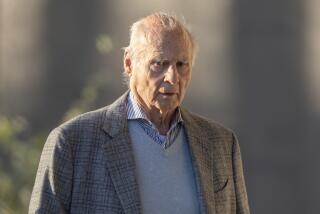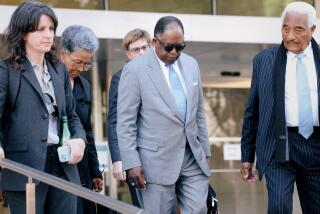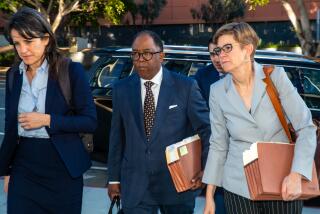Young’s Case in Trouble, Judge Tells Prosecutor
- Share via
In an unusual warning to federal prosecutors, the judge presiding over the political corruption trial of former legislator Bruce E. Young said Wednesday that there is a “real question” as to whether there was anything illegal about a controversial $50,000 financial transaction involving Young in 1979.
U.S. District Judge Dickran Tevrizian waited until the end of a full day of testimony by David King, a former accountant for convicted political corrupter W. Patrick Moriarty, before telling the prosecution that a key portion of the government case against Young is in trouble.
Tevrizian, reminding the government that it must prove its case against Young “beyond a reasonable doubt,” said he was troubled by King’s “creative accounting” methods and his testimony about a $50,000 investment Young originally made with Moriarty in 1979.
Young’s investment, which was initially recorded on Moriarty’s business books both as a “loan” to Young and a “loan” to Moriarty, was never fully repaid.
The government claims that in 1981, Moriarty told Young that he had placed the $50,000 in a Baldwin Hills condominium project and promised Young a “2-for-1” return on his money. Young’s version at various times has been that there was no such agreement until 1982 and that he reported his financial interest at that time as required by state law.
Tevrizian’s concerns focused on two areas: whether the transaction was a “loan” or a legitimate investment and whether the government has met its burden in establishing its charge that Young and Moriarty had solidified their agreement in 1981 instead of a later date.
“With respect to King’s testimony, it’s my understanding that if Young loaned the money to Moriarty he need not have reported it,” Tevrizian told Chief Assistant U.S. Atty. Richard E. Drooyan outside the presence of jurors. “The real issue then is when was that loan--if ever--converted from a personal loan to an investment prior to 1982 as the government contends.
“The point is, in a criminal case, the burden of proof is beyond a reasonable doubt,” Tevrizian continued. “You have to prove there was a corrupt scheme. If the defense is correct that Mr. Young did nothing illegal . . . it could have started out as a harmless investment that went sour along the way.”
Tevrizian’s comments to Drooyan, who has led the continuing Moriarty investigation for the last three years, touched off a spirited exchange between the judge and the prosecutor in which Drooyan minimized the importance of King’s testimony and complained of the difficulties in probing Moriarty’s complicated business dealings.
At one point, Drooyan pleaded with the judge not to be “too technical” in assessing the government’s case against Young and argued that prosecutors do not have to prove actual violations of state law to convict Young of federal mail fraud charges in his alleged failure to report income from Moriarty and a cable television firm in 1981 and 1982.
“The court has to be careful about being too technical as to what’s going on in this case,” Drooyan said. “The government does not have to prove that, in fact, there was a violation of state law.
“This is a case about corruption,” Drooyan continued. “A corruption case is ultimately going to turn on Mr. Young. It’s going to revolve around the issue of intent. The accounting things strike me as irrelevant.”
Drooyan added:
“You’re seeing some of the frustrations we’ve gone through in the last 3 1/2 years investigating this. It (Moriarty’ bookkeeping practices) was absolutely creative financing. I just think we’re getting all hung up on creative financing.
“It’s not the way I’d keep my books if I had a business, and I’m sure it’s not the way you’d keep yours. I just ask that you not be too technical in looking at this.”
Rejecting Drooyan’s argument, Tevrizian said he does regard the question of Young’s $50,000 business venture with Moriarty as one that revolves around “technical” accounting questions and observed that he was an accountant himself with the firm of Arthur Anderson & Co. before beginning his legal career.
“This accounting today--it bothered me,” Tevrizian said. “On the 2-for-1 (investment promise by Moriarty), these liabilities were shown at understated value. If you put 10 accountants up there, not one would agree with him. I say this because I majored in accounting and I was with Arthur Anderson.”
While Tevrizian criticized the government’s presentation of evidence pertaining to Young’s $50,000 business deal with Moriarty, in which Young ultimately lost between $20,000 and $30,000, he made it clear that he was referring to other charges in the 28-count mail fraud case.
Those charges include allegations that Young received an unreported $10,000 in consulting fees from a cable television firm and free use of a leased Ford Bronco while working as a consultant to Moriarty.
More to Read
Get the L.A. Times Politics newsletter
Deeply reported insights into legislation, politics and policy from Sacramento, Washington and beyond. In your inbox twice per week.
You may occasionally receive promotional content from the Los Angeles Times.










